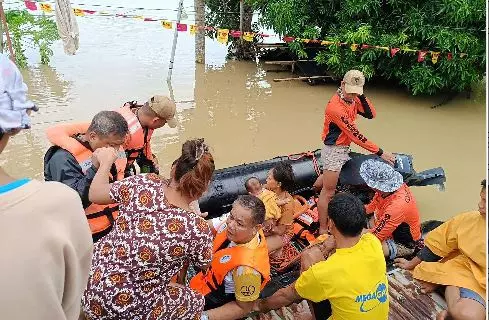
Manila: Rescuers in the Philippines are wading through chest-deep floodwaters to reach residents stranded by Tropical Storm Trami, which has claimed seven lives and forced thousands to evacuate as it approaches the east coast.
The storm’s torrential rains have transformed streets into rivers, submerged entire villages, and buried vehicles under volcanic sediment released by the downpour. Authorities report that at least 32,000 people have fled their homes in northern regions as Trami moves closer to Luzon, the Philippines’ main island.
In the Bicol region, about 400 kilometers (249 miles) southeast of Manila, “unexpectedly high” flooding has complicated rescue operations, according to local police. “Rescue teams struggled to enter some areas due to the strong currents,” regional police spokeswoman Luisa Calubaquib said.
Tragedy struck when a person drowned inside a bus swept away by floodwaters in Naga, where three others also lost their lives. Additionally, an elderly woman drowned in Quezon province, and a toddler died after falling into a flooded canal. In Manila, one fatality was reported due to a falling tree branch.
As of 2 pm (0600 GMT), Trami’s center was located 160 kilometers east of Aurora province, with maximum sustained winds of 85 kilometers per hour. The storm is forecasted to hit the northeastern coast near Divilacan around 11 PM (1500 GMT).
Pictures depict streets in Camarines Sur’s Bato municipality inundated by muddy waters, with only rooftops visible. Resident Karen Tabagan expressed fear, saying, “It’s getting dangerous. We’re waiting for rescuers.”
In Naga, approximately 40 kilometers from Bato, half of the 600 villages were fully submerged. During an emergency meeting, President Ferdinand Marcos remarked that “the worst is yet to come,” adding, “I’m feeling a little helpless… all we can do is sit tight, wait, hope and pray.”
Families displaced by the flooding are being sheltered in around 2,500 evacuation centers across the Bicol region. There have also been reports of lahar flows in Albay, triggered by the rains, while authorities evacuated coastal residents near Divilacan due to warnings of potentially life-threatening storm surges.
Typhoons are common in the region during this season, but climate change has led to storms forming closer to coastlines, intensifying rapidly and lasting longer over land. Each year, about 20 major storms and typhoons impact the Philippines, causing significant damage and loss of life.






